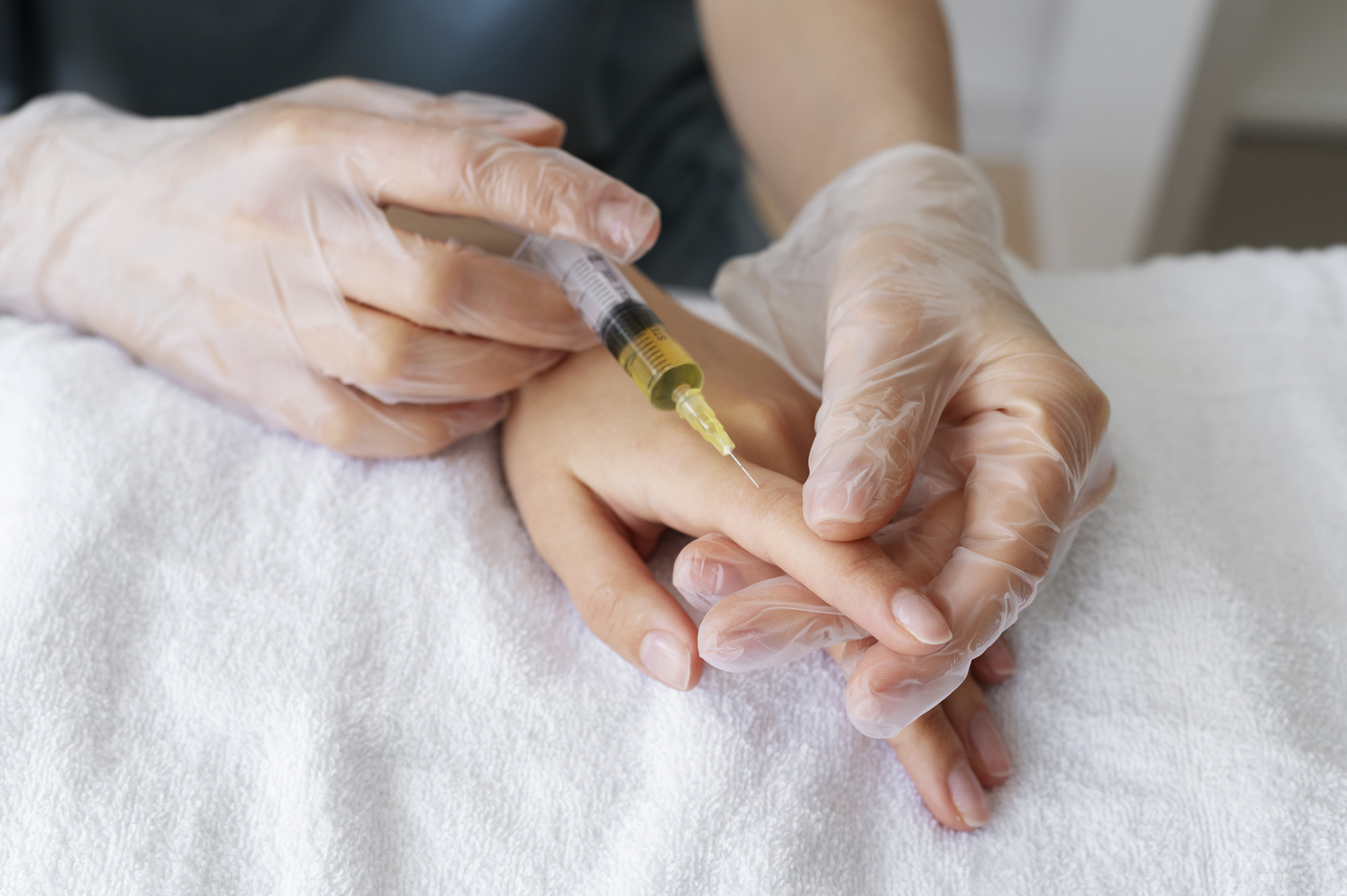Login Form
Registration
Profile Informations
Login Datas
or login
Everything You Need to Know About Dermal Fillers for Hands
Everything You Need to Know About Dermal Fillers for Hands
The hands often serve as telltale indicators of age, revealing the passage of time through visible veins, prominent tendons, and thinning skin. While many people invest in facial anti-aging treatments, the hands frequently remain overlooked despite being one of the most exposed parts of the body.
Understanding Hand Aging
Hand aging occurs through a natural process that affects multiple layers of skin and underlying tissue. The subcutaneous fat layer gradually diminishes with age, causing the skin to lose its plump, youthful appearance. Collagen and elastin production also decreases, leading to reduced skin elasticity and the formation of fine lines.
Why Hands Show Age So Prominently
Several factors contribute to the aged appearance of hands:
-
1. Volume loss: Decreased fat padding makes veins and tendons more visible
-
2. Collagen depletion: Reduced protein structures cause skin to become thinner
-
3. Sun damage: Years of UV exposure create age spots and texture changes
-
4. Frequent use: Constant movement and environmental exposure accelerate aging
The combination of these factors creates the characteristic hollow, veiny appearance that many people find concerning. Unlike facial skin, hand skin has fewer sebaceous glands and less natural protection against environmental damage.

What Are Dermal Fillers for Hands
Dermal fillers for hands represent a non-surgical approach to restoring youthful volume and smoothness. These injectable treatments work by adding substance beneath the skin surface to plump areas that have lost natural padding. The procedure specifically targets volume loss rather than addressing surface-level concerns like age spots.
Dermal fillers for hands differ from facial fillers in their application technique and the specific areas treated. The back of the hands requires strategic placement to achieve natural-looking results while avoiding interference with hand function. Professional practitioners use specialized injection techniques designed for the unique anatomy of this area.
Types of Hand Fillers Available
Medical professionals typically choose from several categories of dermal fillers for hand rejuvenation:
Hyaluronic acid fillers:
-
1. Naturally occurring substances in the body
-
2. Provides immediate hydration and volume
-
3. Reversible if results are unsatisfactory
-
4. Common brands include Restylane and Juvederm
Calcium hydroxylapatite fillers:
-
1. Synthetic material that mimics bone structure
-
2. Stimulates natural collagen production
-
3. Longer-lasting results than hyaluronic acid
-
4. Radiesse is the most recognized brand
The choice between different filler types depends on individual skin conditions, desired longevity, and specific aesthetic goals. Each type offers unique benefits that make it suitable for different patients and treatment objectives.
The Treatment Process

Professional hand filler treatments follow a standardized protocol designed to ensure safety and optimal results. The process begins with a thorough consultation where the practitioner assesses the skin condition and discusses expected outcomes.
Pre-Treatment Preparation
Before receiving dermal fillers for hands, patients typically need to follow specific preparation guidelines:
-
1. Avoid blood-thinning medications for 7-10 days
-
2. Discontinue alcohol consumption 24 hours prior
-
3. Stop using certain skincare products that may increase sensitivity
-
4. Arrange transportation if sedation is used
Proper preparation helps minimize bruising and ensures the treatment proceeds smoothly. Patients should inform their practitioner about any medications, supplements, or medical conditions that might affect the procedure.
During the Procedure
The actual injection process for hand dermal fillers usually takes 20-30 minutes per hand. Practitioners begin by cleaning the treatment area and applying a topical numbing cream to enhance comfort. Strategic injection points are identified based on the individual's specific volume loss patterns.
The filler material is carefully injected using either fine needles or blunt-tip cannulas. The practitioner works systematically across the back of each hand, adding volume where needed while maintaining natural contours. Gentle massage may be performed during injection to ensure even distribution.
Most patients describe the sensation as mild discomfort similar to small pinpricks. The numbing cream significantly reduces any pain, making the procedure well-tolerated by most individuals.
Expected Results and Timeline
Dermal fillers for hands provide immediate visible improvement, though final results become apparent once the initial swelling subsides. The treated area appears fuller and smoother right after injection, with continued improvement over the following days.
Short-Term Expectations
Initial results from dermal fillers for hand rejuvenation include:
-
1. Immediate volume restoration
-
2. Reduced visibility of veins and tendons
-
3. Smoother skin texture
-
4. Minor swelling that resolves within 48 hours
The hands may appear slightly overfilled immediately after treatment due to swelling. This temporary effect typically resolves within 24-48 hours, revealing the final result.
Long-Term Outcomes
The longevity of hand filler results varies based on the type of product used and individual factors. Hyaluronic acid fillers generally last 6-12 months, while calcium hydroxylapatite options may provide results for 12-18 months.
Factors affecting duration include metabolism rate, activity level, and the specific filler chosen. Some patients notice gradual improvement beyond the initial treatment as certain fillers stimulate natural collagen production.
Benefits of Hand Rejuvenation
Dermal fillers for hands offer numerous advantages for individuals seeking to improve the appearance of aging hands. The treatment provides a non-surgical alternative to more invasive procedures while delivering noticeable results.
Aesthetic Improvements
The primary benefits of dermal fillers for hands include:
-
1. Volume restoration: Plumps hollow areas and masks prominent veins
-
2. Wrinkle reduction: Smooths fine lines and surface irregularities
-
3. Improved texture: Enhances overall skin quality and suppleness
-
4. Natural appearance: Creates subtle, realistic improvements
These improvements help create hands that better match a person's overall appearance and energy level. The treatment can effectively reverse years of visible aging without requiring surgical intervention.
Practical Advantages
Beyond aesthetic benefits, hand fillers offer practical advantages:
-
1. Minimal downtime allows immediate return to activities
-
2. No scarring or permanent changes to hand structure
-
3. Reversible results with certain types of fillers
-
4. It can be combined with other-hand rejuvenation treatments
The convenience factor makes this treatment appealing to busy individuals who cannot accommodate extended recovery periods.
Potential Risks and Side Effects

While generally safe when performed by qualified practitioners, dermal fillers for hands do carry certain risks that patients should understand before treatment.
Common Side Effects
Most patients experience mild, temporary side effects, including:
-
1. Swelling at injection sites
-
2. Bruising that resolves within a week
-
3. Tenderness or mild pain
-
4. Redness that fades quickly
These effects are normal parts of the healing process and typically resolve without intervention. Cold compresses and over-the-counter pain relievers can help manage discomfort.
Serious Complications
Though rare, more serious complications can occur:
-
1. Infection at injection sites
-
2. Allergic reactions to filler materials
-
3. Vascular occlusion if filler enters blood vessels
-
4. Persistent lumps or irregularities
Choosing an experienced, board-certified practitioner significantly reduces the risk of serious complications. Proper sterile technique and FDA-approved products further minimize potential problems.
Aftercare and Recovery
Proper aftercare following hand filler treatment helps ensure optimal results and minimize complications. Most patients can resume normal activities immediately, though certain precautions should be observed.
Immediate Post-Treatment Care
The first 24-48 hours after receiving dermal fillers for hands require specific attention:
-
1. Apply cold compresses to reduce swelling
-
2. Keep hands elevated when possible
-
3. Avoid strenuous activities or heavy lifting
-
4. Stay hydrated to support healing
Gentle movement is encouraged to prevent stiffness, but vigorous activity should be avoided until initial swelling subsides.
Long-Term Maintenance
Maintaining results from hand dermal fillers involves:
-
1. Following up with the practitioner as recommended
-
2. Protecting hands from excessive sun exposure
-
3. Using moisturizers to support skin health
-
4. Scheduling touch-up treatments as needed
Regular maintenance helps extend the longevity of results and keeps hands looking their best over time.
Choosing the Right Provider
Selecting a qualified practitioner represents one of the most important decisions in achieving successful hand filler results. The provider's experience and expertise directly impact both safety and aesthetic outcomes.

Practitioner Qualifications
Look for providers with:
-
1. Board certification in dermatology or plastic surgery
-
2. Specific experience with hand filler treatments
-
3. Positive patient reviews and before/after photos
-
4. Proper licensing and clean facility standards
The practitioner should be willing to discuss their experience, show examples of their work, and answer all questions thoroughly.
Treatment Facility Standards
A reputable treatment facility should maintain the following:
-
1. Sterile procedure rooms
-
2. Emergency protocols and equipment
-
3. FDA-approved filler products
-
4. Proper storage and handling of materials
These standards ensure patient safety and treatment effectiveness while reducing the risk of complications.
Cost Considerations
The investment in dermal fillers for hand rejuvenation varies based on several factors, including geographic location, practitioner experience, and amount of product needed.
Factors Affecting Price
Treatment costs typically depend on:
-
1. Type and amount of filler required
-
2. Practitioner's expertise and reputation
-
3. Geographic location and local market rates
-
4. Additional services included in the treatment
Most patients require 1-2 syringes per hand, though individual needs vary based on the degree of volume loss and desired results.
Value Assessment
When evaluating the cost of hand dermal fillers, consider:
-
1. Longevity of results compared to other treatments
-
2. Non-surgical nature eliminates surgical fees
-
3. Minimal downtime reduces lost income
-
4. Potential for combining with other procedures
The investment often proves worthwhile for individuals seeking effective hand rejuvenation without surgical intervention.
To Sum Up: Making an Informed Decision
Deciding whether dermal fillers for hands are appropriate requires careful consideration of individual goals, expectations, and circumstances. The treatment works best for people with realistic expectations about possible outcomes.
Dermal fillers for hands represent an effective solution for addressing volume loss and creating more youthful-looking hands. The procedure offers immediate results with minimal downtime, making it an attractive option for many people concerned about hand aging.
Understanding the treatment process, potential risks and expected outcomes helps ensure satisfaction with the final results. Consultation with a qualified practitioner provides personalized guidance for achieving optimal hand rejuvenation outcomes.


